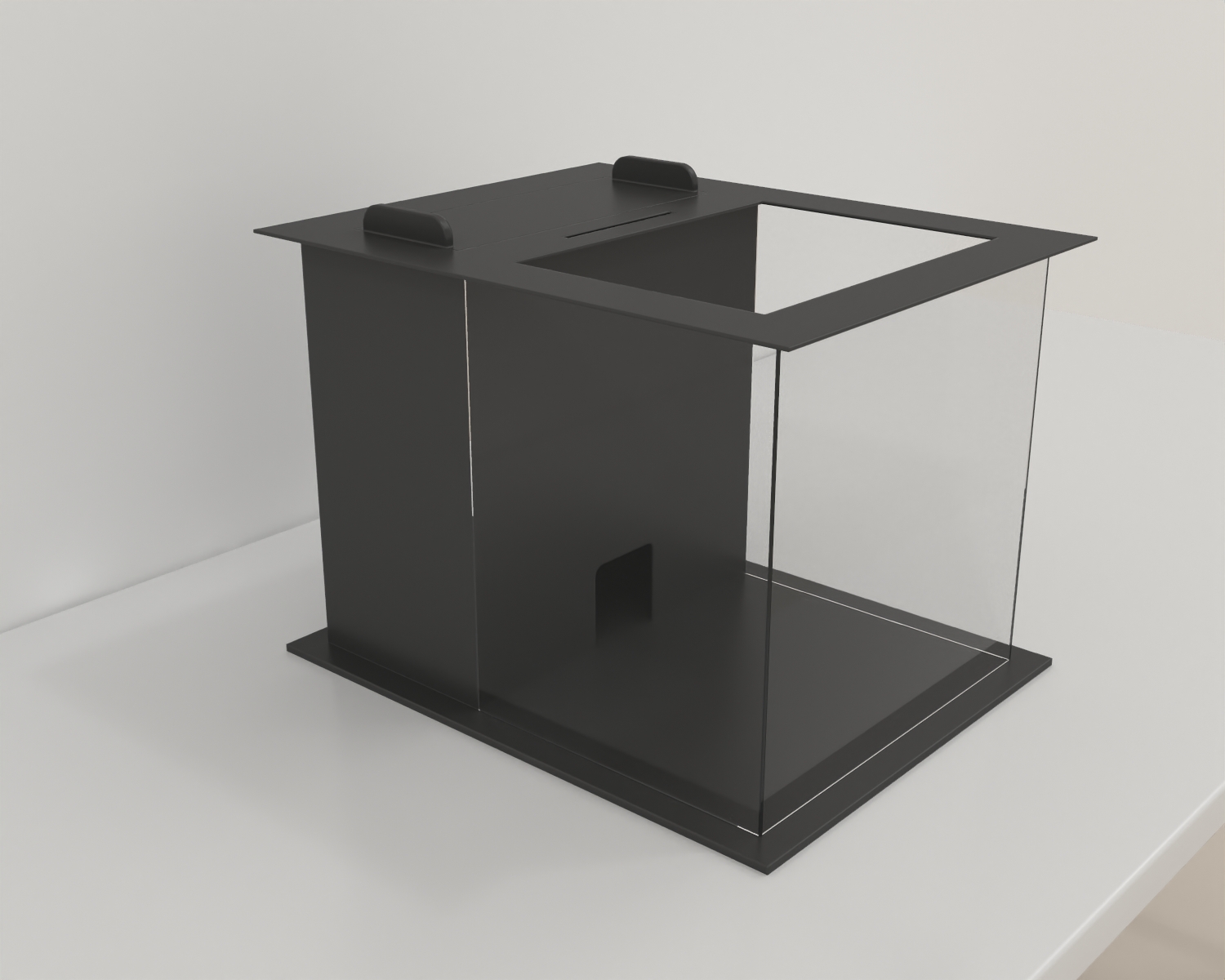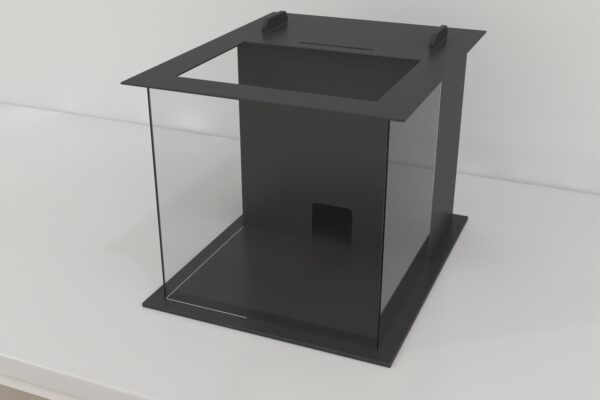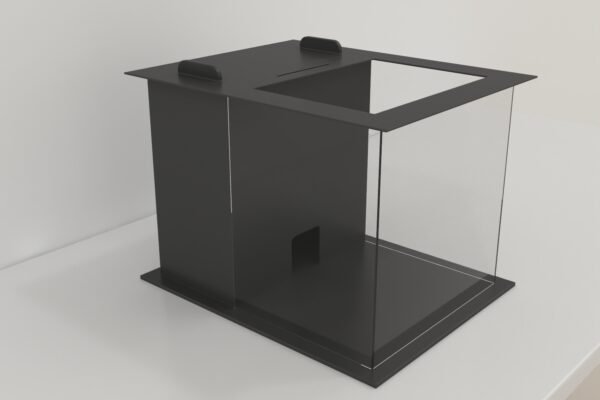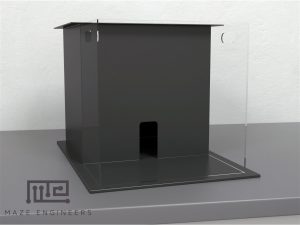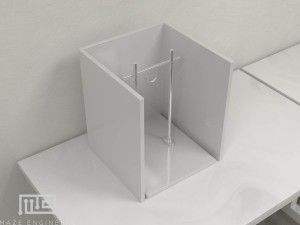The Open Topped Apparatus is a modified version of the Light/Dark Box used to study anxiety-related behaviors in rodents. It includes a chamber divided into two portions: a larger “light” side with transparent acrylic walls, a smaller “dark” side with opaque walls and an opening with a partition connecting the two sides. Both light and dark compartments have an IR permeable lid that keeps them open or closed and allows for tracking of the rodents location.
Price and Specifications
Mouse
$ 1190
Per Month- 18cm x 27 x 30cm dark chamber; 27 x 27 x30 cm light chamber; 7.5 × 7.5 cm corridor
- Lids for both dark and light chambers with IR permeable lid for the dark chamber
- Acrylic
- Easy clean with 70% Ethanol
- No Odors
- Matte Finish to remove shine
Rat
$ 1390
Per Month- 29cm x 43 x 48cm dark chamber; 43 x 43 x48 cm light chamber; 12 × 12 cm corridor
- Lids for both dark and light chambers with IR permeable lid for the dark chamber
- Acrylic
- Easy clean with 70% Ethanol
- No Odors
- Matte Finish to remove shine
Introduction
The Rodent Open Topped Apparatus test, similar to the light/dark test, is based on the approach-avoidance conflict between rodents’ innate aversion to brightly illuminated and open areas and on the spontaneous exploratory behaviors in novel environments (Arrant, Schramm-Sapyta, & Kuhn, 2013). During the test, the subject can explore the apparatus and move freely between the light and dark chambers. An increase in the number of crossings between the two compartments indicates reduced anxiety-related behaviors. Moreover, the time spent on the light side and the distance traveled also reflect anxiety-like behaviors. Therefore, the Rodent Open Topped Apparatus is useful for studies investigating the efficacy of anxiolytic and anxiogenic drugs and psychostimulants on anxiety-related behaviors.
Other apparatuses used to study rodent anxiety includes the Successive Alleys Apparatus, the Tail Suspension Apparatus, the Elevated Plus Maze, and the Sleep Deprivation Chamber.
Apparatus and Equipment
The Rodent Open Topped Apparatus is constructed of acrylic. It is divided into two portions by a partition and comprises a clear “light” side that is smaller and a fully opaque “dark” side. A opening connects the light and dark sides.
The light compartment includes a clear plexiglass lid, which can be opened or closed. It is recommended that a 60-W light bulb illuminates the light side with ∼400 lux. The dark side can be either completely shielded from view or equipped with a lid-mounted observation window and a 60-W red lamp to provide illumination of <10 lux. The white light on the other side must be appropriately directed only towards the light side if the dark side is equipped for observation to prevent any light from leaking into the dark compartment.
Rodent location can be tracked using a video tracking software package such as Noldus EthoVision, ANY-Maze, or BehaviorCloud.
Training Protocol
Bring the subject inside the test room at least an hour before the test and shield them from outside disturbances. The subject can either be tested in the morning for a standard light cycle or in the afternoon for a reversed cycle. Adapt the subjects for three weeks before testing if the reversed cycle is used. To reduce diurnal variance, standardize the testing time. Place the subject in a holding cage after administering a drug or vehicle to them. The drug and injection route influence the time between the injection and the test. To reduce the injection’s stressful effects, provide at least 10 minutes of rest before beginning testing.
Clean the apparatus after each trial by wiping it with water, removing feces, and wiping urine. Clean the apparatus with water and a mild laboratory detergent after each testing day. Avoid using detergents with strong scents.
Rodent Open Topped Apparatus Task
Place the subject in the middle of the light compartment of the apparatus, facing away from the opening. Allow the subject to explore the apparatus for 5 to 10 minutes. Record the number of crossings the subject makes from the light side to the dark side, the time spent on each side, and the time taken to first enter the dark compartment. Remove the subject from the apparatus and return it to its home cage.
Minimize distracting stimuli from affecting the mice during task performance by raising the apparatus off the floor.
Data Analysis
The following parameters can be observed using the Rodent Open Topped Apparatus:
- The number of crossings made by the subject from the light to the dark side of the apparatus
- The time spent on each side
- The latency period before first leaving the light side and entering the dark side
- The distance travelled on each side of the apparatus
Literature Review
Investigation of the effect of anxiolytic and anxiogenic agents and psychostimulant drugs on the Rodent Open Topped Apparatus
HascoëT (1998) utilized the Rodent Open Topped Apparatus to test the effects of well-known anxiolytic drugs diazepam and alprazolam, as well as the potential anxiogenic FG 7142.. Additionally, the effects of increasing locomotor activity on anxiety indices were investigated using psychostimulant medications (including caffeine, amphetamine, adrafinil, and amineptine). Male Swiss and C57Bl/6J mice were used in the study to observe strain differences. Three conditions were tested in the apparatus during the experiments: (a) a clean vs. a soiled apparatus (Swiss strain of mice treated with diazepam). For the clean apparatus, any fecal pellets were taken out at the end of each session, and the floor of the boxes was washed with detergent and dried. For the soiled apparatus, the mice not utilized for testing were placed in the apparatus 30 minutes before trials. (b) two different strains of mice were given diazepam (soiled apparatus); and (c) the effects of anxiolytic/anxiogenic drugs and psychostimulant agents were compared (Swiss strain, soiled apparatus).
The subjects were injected with saline or treatment before testing. During the experiment, individual subjects were placed in the light compartment and were allowed to explore the apparatus and enter the dark apartment. The results indicated that treatment with diazepam lengthened the time spent in the light compartment at doses of 1 mg/kg to 4 mg/kg in the soiled setting. Moreover, at doses of 2 and 4 mg/kg, sedative effects, including a substantial decrease in transitions and locomotion occurred. The mice took longer to enter the dark after receiving the 4 mg/kg dose. Diazepam treatment in a clean apparatus did not show any anxiolytic effect for nonsedative doses, with an increase in time spent in the light compartment only for 2 and 4 mg/kg doses. Alprazolam and diazepam were shown to have an anxiolytic characteristics. There was no indication of an intrinsic effect with FG 7142. Aminoptine, adrafinil, and caffeine solely exhibited a psychostimulant character, whereas amphetamine was reported to have anxiogenic properties. A comparison of strain differences revealed that the Swiss mice C57Bl/6J mice’s movement levels were slightly higher than the Swiss mice when evaluated in the soiled apparatus. Moreover, the C57Bl/6J mice didn’t exhibit much anxiolytic activity in control situations.
Investigation of the effect of Cyamemazine on anxiety-related behaviors
Bourin (2001) investigated the effect of Cyamemazine on reducing anxiety-related behaviors using the Rodent Open Topped Apparatus. Male Swiss mice four weeks old were used in the study. Acute and chronic administration of Cyamemazine was conducted. In acute experiments, it was administered i.p. 30 minutes before testing, whereas in chronic studies, it was administered twice a day i.p. for 10 days. Trials were conducted 30 minutes after the last injection. Additionally, serotonergic ligands were given i.p. 45 minutes before testing, with the last cyamemazine i.p. administration 30 min before testing.
A soiled apparatus was always used for testing and was never cleaned between trials to reduce neophobic responses to the test situation. During testing, naive mice were individually positioned in the centre of the light area, facing away from the opening, and allowed to explore the apparatus for 5 minutes. The results indicated that cyamemazine caused a reduction in the amount of time spent in the dark compartment for doses of 0.375 and 0.5 mg/kg. However, the number of transitions between the compartments, the latency, and the movements in the dark compartment were all significantly reduced by the cyamemazine dose of 0.5 mg/kg.
Strengths and Limitations
Strengths
The Rodent Open Topped Apparatus can measure anxiety-related behaviors in rodents. Unlike the Traditional Lght/Dark box, the Rodent Open Topped Apparatus includes an IR permeable lid for both light and dark compartments, which can be kept open or closed. Therefore, rodent behaviors can be observed in the dark compartment as well. The apparatus is useful for studying anxiolytic drugs since the number of crossings between the light and dark compartments are increased by anxiolytics but not by nonanxiolytics.
Limitations
If the dark compartment lid is kept open for observation, it is necessary to properly direct the white light on the light side, such that it only illuminates the light compartment and does not leak into the dark compartment. Unintentional stimuli may affect results, which may be reduced by raising the apparatus off the floor and limiting external noise. Rodents of different strains and gender may produce variable results.
Summary
The Open Topped Apparatus is a modified version of the Light/Dark Box used to study anxiety-related behaviors in rodents.
- The apparatus includes a chamber divided into a light side with clear acrylic walls and a dark side with opaque walls. Both sides include an IR permeable lid, which can be kept open or closed, allowing rodents to be observed in both compartments.
- The Open Topped Apparatus test is based on the approach-avoidance conflict between rodents’ innate aversion to brightly illuminated and open areas and on the spontaneous exploratory behaviors in novel environments.
- Rodent crossings between the light and dark compartments, as well as the time spent in each compartment, are used to assess anxiety.
- The Open Topped Apparatus is sensitive to anxiolytic drugs. Therefore, it can be used to assess their efficacy.
References
Arrant, A. E., Schramm-Sapyta, N. L., & Kuhn, C. M. (2013). Use of the light/dark test for anxiety in adult and adolescent male rats. Behavioural brain research, 256, 119–127. https://doi.org/10.1016/j.bbr.2013.05.035
Hascoët, M., & Bourin, M. (1998). A new approach to the light/dark test procedure in mice. Pharmacology, biochemistry, and behavior, 60(3), 645–653. https://doi.org/10.1016/s0091-3057(98)00031-8
Bourin, M., & Hascoët, M. (2003). The mouse light/dark box test. European journal of pharmacology, 463(1-3), 55–65. https://doi.org/10.1016/s0014-2999(03)01274-3
File, S. E., Lippa, A. S., Beer, B., & Lippa, M. T. (2004). Animal tests of anxiety. Current protocols in neuroscience, Chapter 8, . https://doi.org/10.1002/0471142301.ns0803s26

